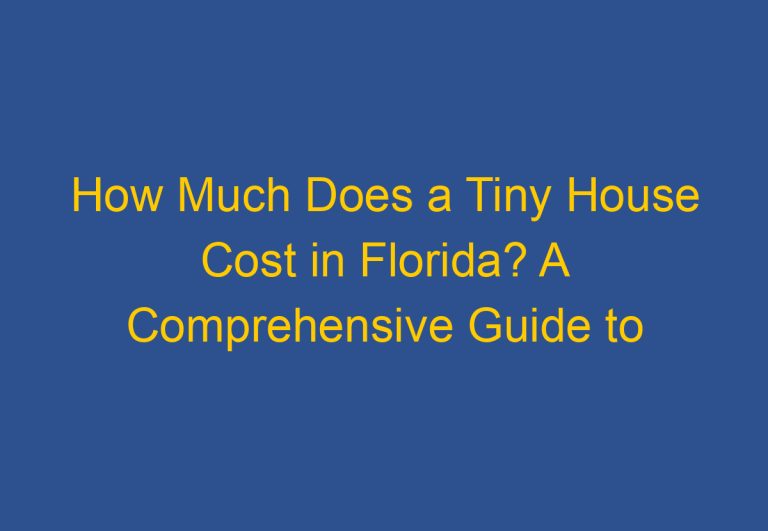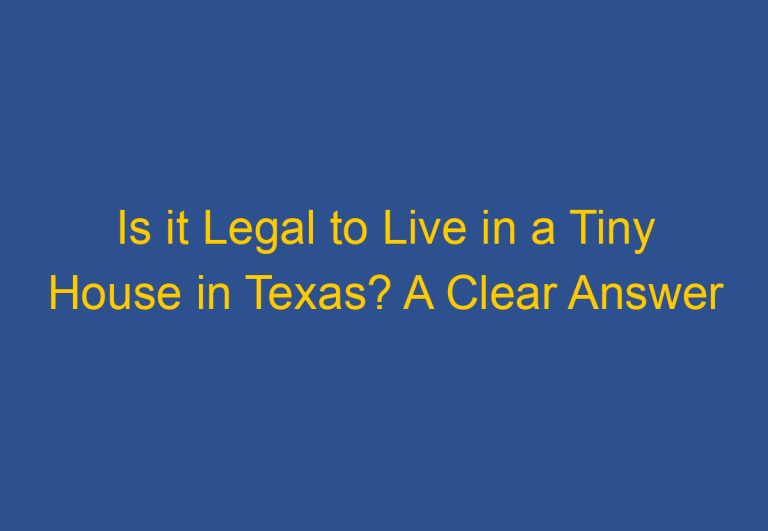Can I Buy Land and Put a Tiny Home on It in Texas? A Guide to Tiny Home Living in the Lone Star State
If you’re considering living in a tiny home in Texas, one of the first questions on your mind might be whether you can buy land and put a tiny home on it. The answer is yes, but there are some regulations and restrictions that you need to be aware of before you start the process.
First and foremost, it’s important to note that Texas does not have a statewide definition for tiny homes. Instead, local land-use rules and regulations are based on the International Residential Code (IRC). This means that the rules and regulations for tiny homes can vary depending on where you are in the state.
However, most Texas counties do not expressly prohibit tiny homes. That being said, the house owner will still need to comply with other regulations that indirectly impact land use. For example, transportation standards may require an access permit and may impose setbacks from nearby public roads to make sure your use does not interfere with traffic.
Understanding Tiny Home Regulations in Texas
When it comes to tiny home regulations in Texas, there are a few things you should know. This section will cover zoning laws and building codes, tiny house-specific regulations, and land use and property tax considerations.
Zoning Laws and Building Codes
Zoning ordinances and building codes can vary widely across Texas, which can make it difficult to determine whether you can put a tiny home on a piece of land. However, most Texas counties do not expressly prohibit tiny houses. Nonetheless, the house owner will still need to comply with other regulations that indirectly impact land use. For example, transportation standards may require an access permit and may impose setbacks from nearby public roads to make sure your use does not interfere with.
Tiny House-Specific Regulations
Texas regulations favor tiny homes on a foundation and one can permanently reside in such houses. Any house with an area of less than 400 square feet is considered a tiny house. The height of the ceiling must be a minimum of 6’8″. Rooms that are not bedroom areas must be at least 70 sq. feet.
The permit process can be complex and time-consuming, so it is essential to research and plan accordingly to ensure compliance with all necessary regulations. The lack of statewide regulations for tiny houses in Texas means that building codes and regulation requirements can vary widely.
Land Use and Property Tax Considerations
If you plan to buy land and put a tiny home on it in Texas, you should also consider land use and property tax considerations. Property taxes in Texas are based on the appraised value of the property, so it’s important to understand how your tiny home will be appraised.
In conclusion, while Texas regulations favor tiny homes on a foundation, the permit process can be complex and time-consuming. It is essential to research and plan accordingly to ensure compliance with all necessary regulations.
Purchasing Land and Preparing for Your Tiny Home
When it comes to purchasing land and preparing for your tiny home in Texas, there are several important factors to consider. This section will cover selecting the right location, utility connections and ground preparation, as well as financing and insurance for tiny homes.
Selecting the Right Location
Choosing the right location for your tiny home is crucial. While there are many beautiful areas in Texas, not all of them are suitable for tiny homes. When selecting a location, it is important to consider zoning regulations, building codes, and any other restrictions that may be in place. It is also important to consider proximity to amenities such as grocery stores, medical facilities, and public transportation.
If you are looking for land to purchase, there are several websites that can help you find the perfect spot. Some of the most popular sites include Zillow, Trulia, Land Watch, and Lands of America. Additionally, you may want to consider reaching out to local real estate agents who specialize in land sales.
Utility Connections and Ground Preparation
Once you have selected a location, it is important to ensure that there are utility connections available. This includes electricity, water, and sewage. If connections are not readily available, you may need to install them yourself, which can be costly.
Ground preparation is another important factor to consider. Depending on the location, you may need to clear the land, level the ground, or install a foundation. It is important to consult with a professional contractor to ensure that the ground is properly prepared for your tiny home.
Financing and Insurance for Tiny Homes
Financing a tiny home can be challenging, as many traditional lenders are hesitant to provide loans for such unique properties. However, there are several alternative financing options available, including personal loans, home equity loans, and crowdfunding.
Insurance coverage for tiny homes can also be difficult to obtain. It is important to work with an insurance provider who understands the unique needs of tiny home owners. Additionally, you may want to consider joining a tiny house community or parking your tiny home in an RV or mobile home park, as these options often provide access to insurance coverage.
Overall, purchasing land and preparing for your tiny home in Texas requires careful consideration and planning. By taking the time to select the right location, ensure utility connections and ground preparation are in order, and secure financing and insurance coverage, you can enjoy the many benefits of tiny home living in the Lone Star State.
Frequently Asked Questions
What are the zoning requirements for tiny homes in Texas?
Zoning requirements for tiny homes in Texas vary by county and municipality. Some areas may allow tiny homes as primary residences, while others may only permit them as accessory dwelling units. It’s important to research the zoning regulations in your area before purchasing land for a tiny home.
Is there a minimum lot size required to place a tiny home on land in Texas?
There is no statewide minimum lot size requirement for placing a tiny home on land in Texas. However, some counties and municipalities may have their own minimum lot size requirements. It’s important to research the regulations in your area before purchasing land for a tiny home.
What permits are needed for installing a tiny home in Texas?
The permits required for installing a tiny home in Texas vary by county and municipality. In general, you will likely need a building permit for the construction of the tiny home and a septic permit for the installation of a septic system. It’s important to research the permit requirements in your area before beginning construction on a tiny home.
Are there specific areas or counties in Texas that are more tiny-home friendly?
Some areas and counties in Texas may be more welcoming to tiny homes than others. Brown County, for example, permits tiny houses and has specific regulations regarding building permits, inspections, setbacks, and utilities. It’s important to research the regulations in your area before purchasing land for a tiny home.
How does property taxation apply to tiny homes in Texas?
In Texas, property taxes are based on the value of the land and any structures on the land. The value of a tiny home may be factored into the property tax assessment, but the exact method of assessment may vary by county and municipality. It’s important to research the property tax regulations in your area before purchasing land for a tiny home.
What are the legal restrictions for building a secondary dwelling, like a tiny house, on my property in Texas?
The legal restrictions for building a secondary dwelling, like a tiny house, on your property in Texas vary by county and municipality. Some areas may have specific regulations regarding setbacks, utilities, and construction standards. It’s important to research the regulations in your area before beginning construction on a secondary dwelling.









